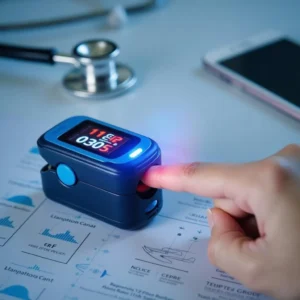
What Happens When Oxygen Levels Drop to 70%? Causes, Risks, and Solutions
Oxygen is essential for life. Every cell in your body relies on it to function properly. But what happens when your oxygen level drops to 70%? This is a critical threshold that can lead to severe health complications, organ damage, and even life-threatening conditions. In this comprehensive guide, we’ll explore the causes, risks, and solutions for low oxygen levels, helping you understand why maintaining healthy oxygen saturation is crucial for your well-being.
Understanding Oxygen Saturation Levels
Oxygen saturation (SpO2) measures the percentage of oxygen in your blood. It’s typically measured using a pulse oximeter, a small device that clips onto your finger.
Normal vs. Dangerous Oxygen Levels:
- Normal Range: 95% to 100%
- Mild Hypoxia: 90% to 94%
- Moderate Hypoxia: 80% to 89%
- Severe Hypoxia: Below 80%
When your oxygen level drops to 70%, it’s considered severe hypoxia, a medical emergency that requires immediate attention.
What Happens When Your Oxygen Level Drops to 70%?
At 70% oxygen saturation, your body struggles to deliver enough oxygen to vital organs and tissues. This can lead to a cascade of symptoms and complications:
Immediate Symptoms:
- Shortness of Breath: Difficulty breathing, even at rest.
- Confusion or Disorientation: Lack of oxygen to the brain affects cognitive function.
- Rapid Heart Rate: The heart works harder to pump oxygen-deprived blood.
- Cyanosis: Bluish discoloration of the skin, lips, or nails due to low oxygen levels.
Long-Term Risks:
- Organ Damage: Prolonged hypoxia can damage the brain, heart, liver, and kidneys.
- Respiratory Failure: The lungs may fail to function properly, requiring mechanical ventilation.
- Cardiac Arrest: Severe oxygen deprivation can lead to heart failure.
For more information on normal oxygen levels, read our article on What is the Normal Range for Oximeter?.
Causes of Low Oxygen Levels
Several factors can cause your oxygen level to drop to 70%. Understanding these causes can help you take preventive measures.
1. Respiratory Conditions:
- Chronic Obstructive Pulmonary Disease (COPD): A group of lung diseases that block airflow.
- Pneumonia: Inflammation of the lungs caused by infection.
- Asthma: Narrowing of the airways due to inflammation.
2. Cardiovascular Issues:
- Heart Failure: The heart’s inability to pump blood effectively.
- Pulmonary Embolism: A blood clot in the lungs.
3. Environmental Factors:
- High Altitude: Reduced oxygen levels at higher elevations.
- Carbon Monoxide Poisoning: Prevents oxygen from binding to red blood cells.
4. Other Causes:
- Anemia: Low red blood cell count reduces oxygen-carrying capacity.
- Sleep Apnea: Interrupted breathing during sleep.
For a deeper dive into respiratory health, check out our guide on What is the Highest Rated Oximeter?.
Risks of Prolonged Low Oxygen Levels
When oxygen levels remain at 70% for an extended period, the risks escalate significantly:
1. Brain Damage:
- Hypoxic Brain Injury: Lack of oxygen can cause permanent brain damage within minutes.
- Cognitive Impairment: Memory loss, difficulty concentrating, and reduced mental clarity.
2. Heart Complications:
- Arrhythmias: Irregular heartbeats due to oxygen deprivation.
- Myocardial Infarction: Heart attack caused by insufficient oxygen supply.
3. Multi-Organ Failure:
- Kidney Failure: Reduced oxygen can impair kidney function.
- Liver Damage: The liver may struggle to detoxify the body.
How to Monitor and Improve Oxygen Levels
If you suspect low oxygen levels, it’s crucial to act quickly. Here’s what you can do:
1. Use a Pulse Oximeter:
- Regularly monitor your SpO2 levels, especially if you have a respiratory or cardiovascular condition.
- Learn more about accurate readings in our article on Which Finger Oximeter is Most Accurate?.
2. Seek Medical Attention:
- If your oxygen level drops to 70%, seek emergency care immediately.
- Hospitals may provide supplemental oxygen or mechanical ventilation.
3. Lifestyle Changes:
- Quit Smoking: Smoking damages the lungs and reduces oxygen levels.
- Exercise Regularly: Improves lung capacity and circulation.
- Maintain a Healthy Diet: Foods rich in iron and antioxidants support oxygen transport.
Preventive Measures to Avoid Low Oxygen Levels
Prevention is always better than cure. Here are some steps to maintain healthy oxygen levels:
1. Stay Hydrated:
- Proper hydration ensures optimal blood volume and oxygen transport.
2. Avoid Pollutants:
- Limit exposure to air pollution, smoke, and chemicals that can harm your lungs.
3. Practice Breathing Exercises:
- Techniques like pursed-lip breathing and diaphragmatic breathing can improve lung function.
4. Use Air Purifiers:
- Clean indoor air reduces the risk of respiratory issues.
Frequently Asked Questions (FAQs)
1. Can low oxygen levels be reversed?
Yes, with prompt medical intervention, low oxygen levels can often be reversed. However, prolonged hypoxia may cause irreversible damage.
2. How can I increase my oxygen levels at home?
- Use a pulse oximeter to monitor levels.
- Practice deep breathing exercises.
- Ensure proper ventilation in your living space.
3. What are the signs of low oxygen levels during sleep?
- Loud snoring
- Gasping for air
- Morning headaches
- Excessive daytime fatigue
For more details, read our article on What Are Normal Readings on a Pulse Oximeter?.
Conclusion: Act Fast to Protect Your Health
A drop in oxygen levels to 70% is a serious medical emergency that requires immediate attention. By understanding the causes, risks, and solutions, you can take proactive steps to protect your health and prevent complications.
If you have concerns about your oxygen levels or need personalized advice, don’t hesitate to contact us or reach out via WhatsApp. Your health is our priority, and we’re here to help you stay informed and safe.
Meta Description:
“What happens when your oxygen level drops to 70? Learn about the causes, risks, and solutions for severe hypoxia. Contact us today for expert advice and support!”
Image Description:
A high-quality image of a person using a pulse oximeter on their finger, with a concerned expression. The background includes a hospital setting, emphasizing the urgency of monitoring oxygen levels.
